Brazzaville
 From Nwe
From Nwe | Brazzaville | |
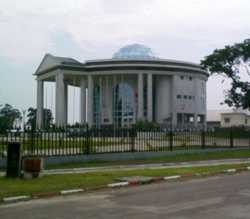
|
|
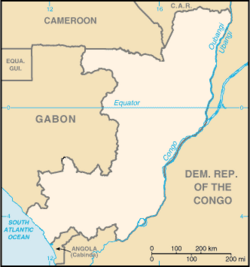
Brazzaville
|
|
| Coordinates: 4°16′S 15°17′E | |
|---|---|
| Country | Republic of the Congo |
| Capital district | Brazzaville |
| Government | |
| - Mayor | Hugues Ngouelondélé |
| Area | |
| - Total | 263.9 km² (101.9 sq mi) |
| Population (2022)[1] | |
| - Total | 2,553,000 |
| - Density | 9,674/km² (25,055.5/sq mi) |
| - Official language | French |
| - National languages | Kituba and Lingala Non-national language : Tsiladi (Lari) |
Brazzaville is the capital and largest city of the Republic of the Congo and is located on the Congo River, across from Kinshasa, the capital of the Democratic Republic of the Congo. It is the only location in the world where two national capitals are situated on opposite banks of the same river.
Brazzaville was founded in 1880, on the site of a village named Nkuna by the Italian born French explorer, Pierre Savorgnan de Brazza, after whom the city was named. The city is the financial and administrative capital of the republic, and it is home to 40 percent of the country's non-agricultural employment. As a key port on the Congo River, Brazzaville sends raw materials to the Atlantic seaport of Pointe Noire for export. Goods arriving at Pointe Noire are shipped to Brazzaville for transport to points north.
The nation was struck by a brief but brutal civil war in 1997, after which an uneasy peace has followed, with sporadic fighting continuing in rural areas of the nation. As the capital, largest city, and economic center of the nation, Brazzaville has a strong foundation, but its future will be determined by the success or failure of the nation to bring lasting peace.
Geography
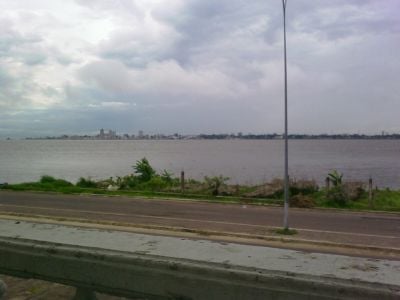
Brazzaville is located 314 miles (506km) inland from the Atlantic Ocean and south of the equator. Surrounded by a vast savanna of high grasslands and dark green thickets of low trees spread over rolling hills, the city is fairly level, with an altitude of 1,040 feet (317 meters), and covers a land area of 38.6 square miles (100 square kilometers).
Located near the Equator, the climate is quite consistent year-round, with the January temperature being a humid 70°F-88°F (21°C-31°C) and July being 63°F-82°F (17°C-28°C). The average yearly rainfall is around 55 inches (1400 mm). The dry season is from June to August while the wet season has two rainfall maxima: One in March–May and another in September–November.
The Congo River Rapids lie on the outskirts of the city, where the Djoué River meets the Congo, rendering river transport from Brazzaville to the Atlantic impossible. To the northeast, the river widens into Stanley Pool, which is 15 miles (24 km) wide and dotted with small islands during the dry season. From Brazzaville inland, the river becomes navigable for 1,000 miles (1600 km).
Brazzaville faces environmental issues including air pollution from vehicle emissions, and water pollution from the dumping of raw sewage. Tap water is not drinkable.
History

The earliest inhabitants were Pygmy peoples, who were largely replaced and absorbed by Bantu tribes during Bantu expansions (1500 B.C.E. to 1000 C.E.) The Bakongo are Bantu groups that occupied parts of present-day Angola, Gabon, and Democratic Republic of the Congo, forming the basis for ethnic affinities and rivalries among those countries.
Several Bantu kingdoms, notably those of the Kongo (1400-1914), the Loango, and the Teke, built trade links leading into the Congo River basin. The first European contacts came in the late fifteenth century with Portuguese explorations, and commercial relationships were quickly established with the kingdoms, trading for slaves captured in the interior. When that commerce ended in the early nineteenth century, the power of the Bantu kingdoms eroded.
The area came under French sovereignty in the 1880s. Franco-Italian explorer Pierre Savorgnan de Brazza (1852-1905) competed with agents of Belgian King Leopold's International Congo Association (later Zaire) for control of the Congo River basin. Between 1882 and 1891, treaties with the local rulers on the river's right bank placed their lands under French protection.
City founded
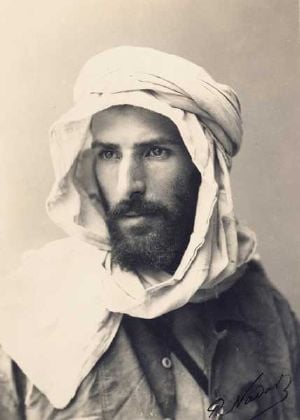
The city was founded on September 10, 1880, on the site of a village named Nkuna by a Franco-Italian explorer, Pierre Savorgnan de Brazza (1852-1905), after whom the city was named. The local leader was Makoko of the Téké, who signed a treaty of protection with de Brazza. The city was built four years later to compete with Léopoldville (later Kinshasa) which was built by the Belgians on the other side of the river. The Brazzaville site was occupied from October 1880 until May 1882, by a small squad of troops led by Senegalese Sergeant Malamine Camara, who prevented a Belgian takeover.
City made capital
French control over the area was made official by the Berlin Conference of 1884. The city became the capital, first of the French Congo, and then, from 1910, of French Equatorial Africa, a federation of states which encompassed Gabon, the Central African Republic, and Chad. The governor-general was based in Brazzaville with deputies in each territory.
Economic development centered on the extraction of natural resources by private companies. In 1924, the Congo-Océan railway was brought into service which linked Brazzaville with the port of Pointe-Noire.
World War II

During World War II (1939-1945), French Equatorial Africa sided with General Charles de Gaulle, and Brazzaville became the symbolic capital of Free France from 1940–1943. The Brazzaville Conference of 1944 heralded a period of reform in French colonial policy. From that conference, the Brazzaville Declaration abolished forced labor and the code de l’indigénat, which made the political and social activities of indigenous people illegal, granted French citizenship to colonial subjects, decentralized certain powers, and elected local advisory assemblies. These changes in turn led to the new French constitution of the Fourth Republic, approved on October 27, 1946, and the election of the first African members of Parliament in Paris.
Expansion
Brazzaville benefited from the postwar expansion of colonial administrative and infrastructure spending since it was the federal capital of French Equatorial Africa. In 1957, near Pointe Indienne, the French Societé des Pétroles de l’Afrique Equatoriale Françaises found oil and natural gas reserves offshore in sufficient exploitable quantities. Until the 1960s, Brazzaville was divided into European (the center of the city) and African sections (Poto-Poto, Bacongo, and Makélékélé).
Independence

A economically weakened France under pressure to free colonies, combined with an upsurge of nationalism within French Equatorial Africa, led to Congo-Brazzaville's autonomy on November 28, 1958, and subsequently independence on August 15, 1960.
Fulbert Youlou, a Catholic priest who had been instrumental in the independence struggle, became the first president until labor elements and rival political parties instigated a three-day uprising that ousted him. The Congolese military took charge of the country briefly and installed a civilian provisional government headed by Alphonse Massamba-Débat, who drew his inspiration from French Marxism.
Under the 1963 constitution, Massamba-Débat was elected president for a five-year term, though with only one party participating. His term ended abruptly in 1968, with a coup d'état. Captain Marien Ngouabi assumed the presidency but continued his predecessor's socialist policies, and one year later proclaiming Congo to be Africa's first "people's republic." Ngouabi announced the decision of the National Revolutionary Movement to change its name to the Congolese Labor Party (PCT). Following Ngouabi's assassination in 1977, Colonel Joachim Yhombi-Opango replaced him as president. Yhombi-Opango was removed from office on February 5, 1979, by the Central Committee of the PCT, which simultaneously designated Vice President and Defense Minister Colonel Denis Sassou-Nguesso as interim President.
Sassou-Nguesso moderated Congo's extremism and and established better relations with Western nations. With the collapse of the Soviet Union, Congo completed a transition to a multi-party democracy with elections in August 1992. Denis Sassou-Nguesso conceded defeat and Congo's new president, Professor Pascal Lissouba, was inaugurated on August 31, 1992.
Thousands killed
On June 5, 1997, President Lissouba's government forces surrounded Sassou's compound in Brazzaville, beginning a four-month conflict that damaged much of Brazzaville and caused tens of thousands of civilian deaths. In early October, Angolan troops invaded, supporting Sassou and, in mid-October, the Lissouba government fell. Soon thereafter, Sassou declared himself president. The Congo Civil War continued for another eighteen months until a peace was struck between the various factions in December, 1999.
New Constitution

Sassou won elections, in 2002, garnering almost 90 percent of the vote. His two main rivals, Lissouba and Bernard Kolelas, were prevented from competing and the only remaining credible rival, Andre Milongo, called for a boycott and withdrew. A new constitution, agreed upon by referendum in January 2002, granted the president new powers, extended his term to seven years, and introduced a new bicameral assembly. International observers criticized the election and the referendum. Voting on June 24, 2007, to choose 137 government deputies for the Republic of Congo National Assembly, drew renewed criticism from international observers.
Government
To distinguish between the two African countries with "Congo" in their names, the Republic of the Congo is sometimes called "Congo-Brazzaville," as opposed to Congo-Kinshasa which is the Democratic Republic of the Congo (known from 1971 to 1997 as Zaire), the capital of which is Kinshasa).
The Republic of Congo's chief of state is the president, who is elected by popular vote for a seven-year term. The president appoints a council of ministers. The bicameral parliament consists of the senate, which has 66 seats, the members of which are elected by indirect vote to serve five-year terms, and the national assembly, which has 137 seats, the members of which are elected by popular vote to serve five-year terms.
The republic consists of 10 regions and one commune, and the regions are subdivided into 46 districts. In 1980, Brazzaville became a commune separated from the Pool Region and divided into seven "arrondissements:" Makélékélé, Bacongo, Poto-Poto, Moungali, Ouenzé, Talangaï, and Mfilou.
Economy
The republic's economy is a mixture of subsistence agriculture, an industrial sector based largely on oil, support services, and a government characterized by budget problems and over staffing. Oil has supplanted forestry as the mainstay of the economy, providing a major share of government revenues and exports. Brazzaville is the financial and administrative capital of the republic, and it is home to 40 percent of non-agricultural employment.
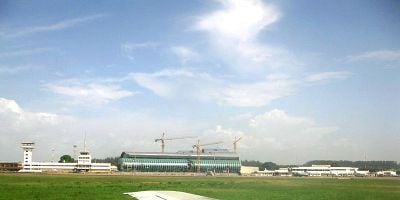
The republic's agricultural products include cassava (tapioca), sugar, rice, corn, peanuts, vegetables, coffee, cocoa, and forest products. Industries involve petroleum extraction, cement, lumber, brewing, sugar, palm oil, soap, flour, and cigarette production.
Industries at Brazzaville include: Machine shops, textiles, tanning, and manufacturing.
As a key port on the Congo River, Brazzaville sends raw materials, such as rubber, wood, and agricultural products, to the Atlantic seaport of Pointe Noire for export. Goods arriving at Pointe-Noire are shipped by rail or truck to Brazzaville, which, due to its position above the rapids, is a transit point for commercial and passenger traffic heading north. Ferries sail to Kinshasa and to Bangui via Impfondo. The port for ferries to Kinshasa is known locally as "The Beach." The city is home to Maya-Maya Airport and a railway station on the Congo-Ocean Railway.
Demographics and culture
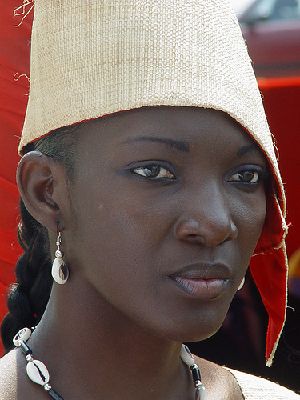
Over a third of the population of the Republic of Congo lives in the capital. Ethnic groups include Kongo (48 percent), Sangha (20 percent), M'Bochi (12 percent), Teke (17 percent), Europeans and other (three percent).
Languages used include French, the official language, Lingala and Monokutuba, which are widely used trade languages, as well as many local languages and dialects (of which Kikongo is the most widespread).
Brazzaville's Marien Ngouabi University, which was founded in 1961, is the sole tertiary institute in the country. It has an average enrollment of 16,500 students.
Brazzaville was a relatively well-developed and thriving city before the civil war began in 1997. Although there continues to be sporadic fighting in the rural areas, the city itself is safe, but the infrastructure has been run down. Many new restaurants and hotels are being built—especially by Lebanese immigrants. Brazzaville is a popular stopover on the way to Pointe Noire or visits to the Congolese rain forests.
Notable buildings in Brazzaville include St. Anne's Basilica, built in 1949, and known for its green tiled roof. Other buildings include the Nabemba Tower and the Congressional Palace. Other features include the Marien Ngouabi Mausoleum, Brazzaville Zoo, and the Poto-Poto School of Painting. The World Health Organization Regional Office for Africa is based in Brazzaville on a vast campus at the Cité du Djoué.
Looking to the future
Brazzaville is the capital and largest city of the Republic of the Congo, a former French colony of western-central Africa. A quarter century of Marxism was abandoned, in 1990, and a democratically elected government installed in 1992. The nation suffered a brief but brutal civil war in 1997. Its human rights record remains poor.
Brazzaville is the financial and administrative capital of the republic, and it is home to 40 percent of non-agricultural employment. As a key port on the Congo River, Brazzaville sends raw materials to the Atlantic seaport of Pointe Noire for export. Goods arriving at Pointe-Noire are shipped to Brazzaville for transport to points north. Petroleum extraction from offshore reserves has supplanted forestry as the mainstay of the nation's economy. Due to instability, full advantage has not been taken of Congo's natural resources. The nation's leaders face the difficult economic problems of stimulating recovery and reducing poverty.
Additional problems are excess mortality due to AIDS, which can result in lower life expectancy, higher infant mortality, higher death rates, lower population growth rates, and changes in the distribution of population by age and gender than would otherwise be expected.
Brazzaville was a relatively well-developed and thriving city before the civil war began in 1997. An uneasy peace has followed with sporadic fighting in rural areas of the nation. As the capital, largest city and economic center of the nation, Brazzaville has a strong foundation, but its future will be determined by the success or failure of the nation in bringing lasting peace and economic reform.
Notes
- ↑ Brazzaville, Congo Metro Area Population 1950-2022 Macrotrends. Retrieved April 19, 2022.
References
ISBN links support NWE through referral fees
- eDiplomat. Congo-Brazzaville. Retrieved April 19, 2022.
- Gondola, Ch. Didier. "Brazzaville." Encyclopedia of African History(2005): 171-173. OCLC 61749617
- Petringa, Maria. Brazzà, a life for Africa. Bloomington, IN: AuthorHouse, 2006. ISBN 978-1425911980
External links
All links retrieved April 19, 2022.
- Brazzaville, Congo FallingRain Maps
- Brazzaville UNESCO Creative Cities Network
- Brazzaville State Magazine
- Brazzaville Journeys by Design
|
|||||||||||||
Credits
New World Encyclopedia writers and editors rewrote and completed the Wikipedia article in accordance with New World Encyclopedia standards. This article abides by terms of the Creative Commons CC-by-sa 3.0 License (CC-by-sa), which may be used and disseminated with proper attribution. Credit is due under the terms of this license that can reference both the New World Encyclopedia contributors and the selfless volunteer contributors of the Wikimedia Foundation. To cite this article click here for a list of acceptable citing formats.The history of earlier contributions by wikipedians is accessible to researchers here:
- Brazzaville history
- History_of_the_Republic_of_the_Congo history
The history of this article since it was imported to New World Encyclopedia:
- History of "Brazzaville"
Note: Some restrictions may apply to use of individual images which are separately licensed.
↧ Download as ZWI file | Last modified: 02/03/2023 23:02:40 | 20 views
☰ Source: https://www.newworldencyclopedia.org/entry/Brazzaville | License: CC BY-SA 3.0
 ZWI signed:
ZWI signed: KSF
KSF